
However they also found that the extra hour of sleep after the clocks went back in autumn decreased the risk of heart attacks in the first few weekdays after switching. Studies have found that the risk of having a heart attack increases in the first three weekdays after switching to DST in the spring. But critics argue that disruption to circadian rhythms (sleep patterns) can negatively impact on human health. Health impacts are widely touted: people can get more exposure to sunlight through the summer DST months, boosting their vitamin D levels.

Some argue that DST does not really save energy, as less household usage in the evenings in summer might be offset by greater morning usage. But DST has far wider ramifications, for energy use, farming, even mood. Well at this time of year, an hour extra in bed for a start. Photograph: Anton Vaganov/Reuters What are the knock-on effects of daylight saving time? The clocks have stayed there ever since.Ĭlocks inside the control room of an abandoned Soviet-era optical radio telescope, on the slope of Mount Aragats, Armenia. Russia decided to stick with daylight saving all year round in 2011, but that led to darkness at noon in some latitudes, and so in 2014 it reverted to standard time in the autumn. In the antipodes, New Zealand moved its clocks forward at the end of September and Australian states that observe daylight saving (New South Wales, Victoria, South Australia, Tasmania and the Australian Capital Territory) made the switch on the first Sunday in October. In the US, clocks go back on the first Sunday in November. What is happening this year?Īll EU member states move clocks back one hour on Sunday, under a law that harmonises the duration of wintertime to prevent a proliferation of different seasonal changes across neighbouring countries. Many countries dropped the ruse after 1918, only readopt it during the energy crises of the 1970s. The UK took the plunge in May 1916 and has stuck with it ever since. The idea of fiddling with time to save energy or make the day seem longer goes back more than 200 years, though it was not until the first world war that it was finally taken seriously.Ĭoal shortages throughout Europe prompted Germany and its ally Austria-Hungary to take up daylight saving in 1916 to preserve energy, and a flurry of other nations on both sides of the conflict quickly followed suit.

Photograph: hogsvilleBrit/GuardianWitness When did it all start? Sundial on the Wedding Tower on the Darmstadt Mathildenhöhe.


 0 kommentar(er)
0 kommentar(er)
